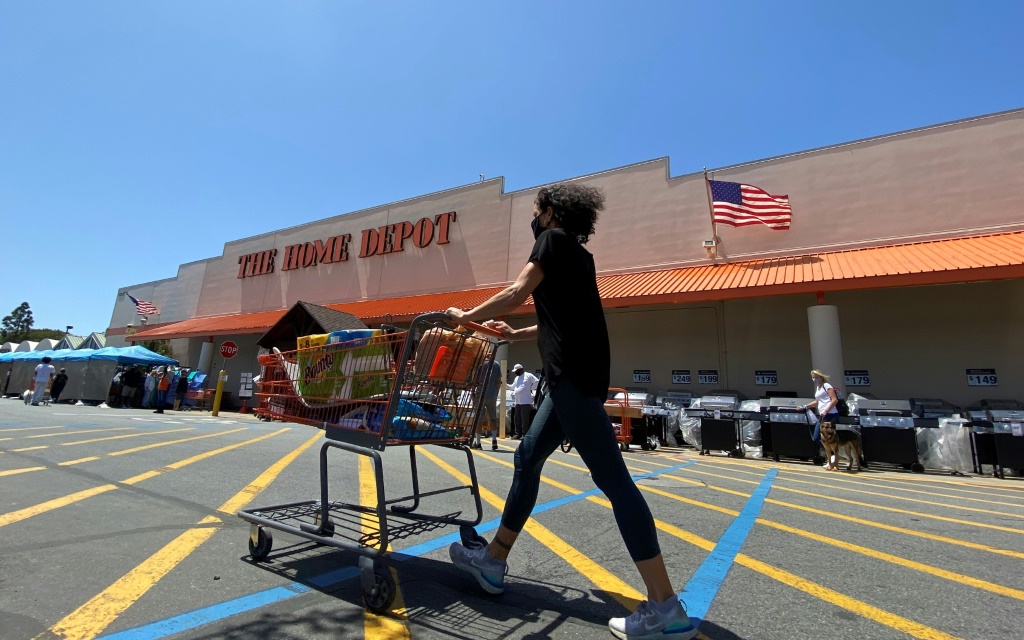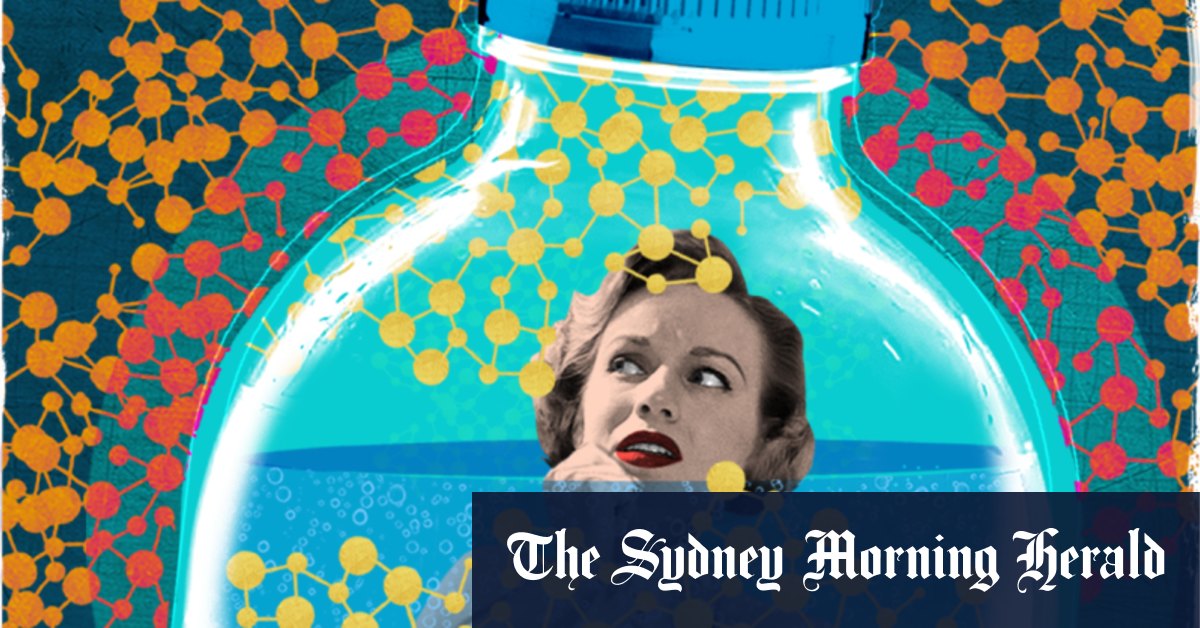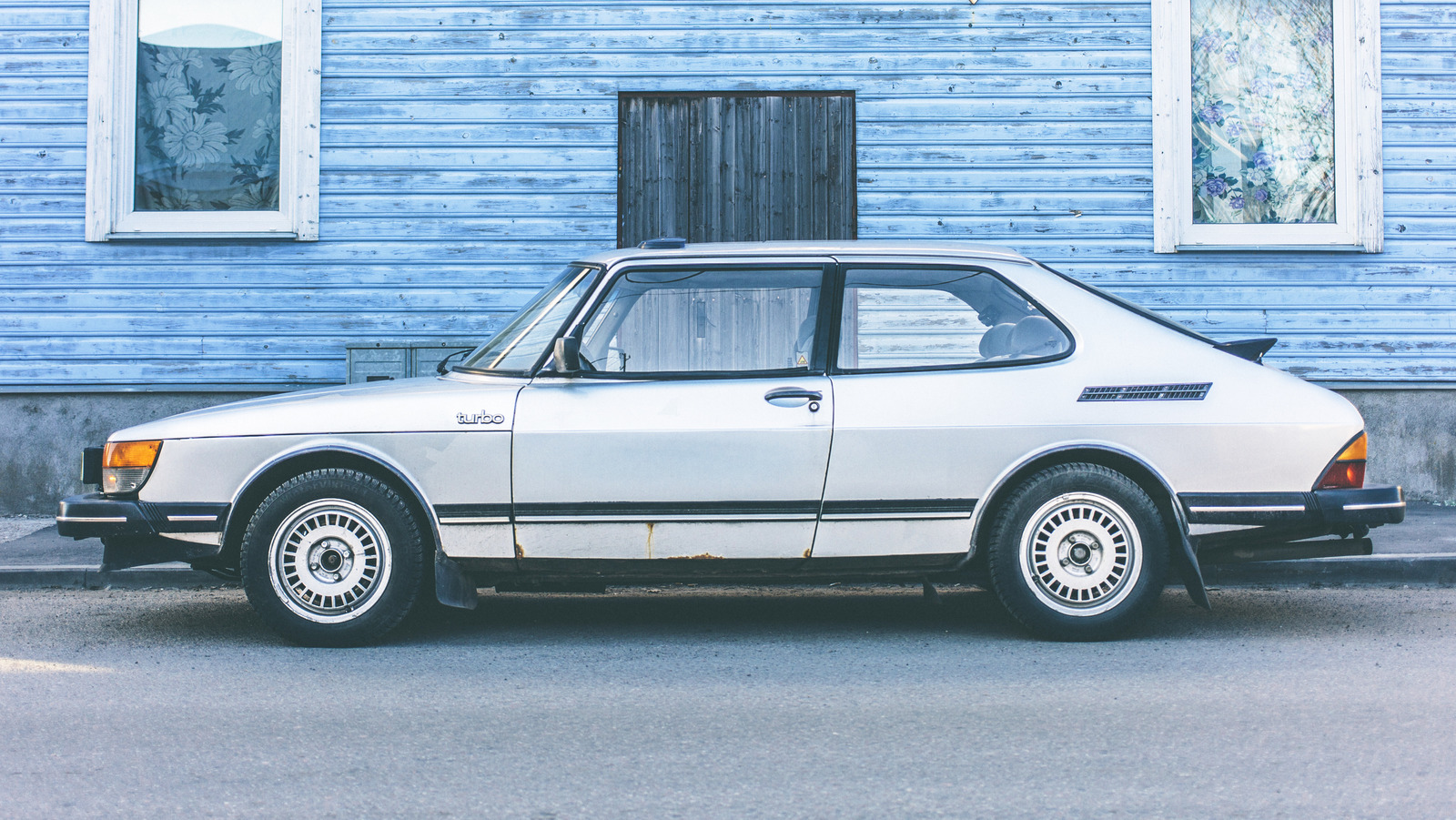Not many California downtowns feature an idle F-4 Phantom supersonic jet tilted on a cement perch, but that’s exactly how the east end of main street in Lancaster begins.
The jet is in Boeing Plaza, at the mouth of a central boulevard in the Southern California city. From there, the road diverts into two slow lanes that straddle a nine-block promenade of shade on the edge of the Mojave Desert.
However, it’s not the city’s dedication to the Mojave’s aerospace legacy that consistently earns it attention from statewide urbanists and city planners. Outsiders point to Lancaster for how it converted its main boulevard from a mundane curb of cars into an attractive tree-lined oasis.
Advertisement
Article continues below this ad
Some 10 years later, the project — which rebranded Lancaster Boulevard as “The BLVD” — has shown some real success: There’s been a boost in business with a rejuvenated city center that’s safer from cars (in a city just 70 miles from traffic hell in Los Angeles, no less). The limitations of the bold move’s effects though, are also apparent; locals warn that The BLVD is unsafe at night, despite the revamp, and that the pedestrian-friendly landscape has become a refuge for the area’s unhoused people.
By choosing people over cars and palm trees over parking spaces, Lancaster became a darling for the new urbanism movement, which counters suburban sprawl by promoting smaller scale, pedestrian-focused downtowns.
Advertisement
Article continues below this ad
An idle F-4 Phantom supersonic jet adorns the east end of The BLVD in Lancaster, Calif., on Oct.18, 2023.
Silas Valentino/SFGATEOn a Wednesday morning in late autumn, I walked the blocks of The BLVD to see for myself.
New gold standard
Across the street from the red-tailed fighter jet in Boeing Plaza is a Metrolink station, the last stop for the Antelope Valley line that cuts into the western tip of the Mojave Desert from Union Station in downtown Los Angeles.
Advertisement
Article continues below this ad
Waiting for the light to cross Sierra Highway, drug use was in full sight across the street from an LA County sheriff’s substation.
Stepping on The BLVD, I noticed it was void of rubbish, compliments of a street team commissioned by the city. They told me they started cleaning at 9 a.m. that morning and will work until 2:30 p.m., as they do every weekday. A shopkeeper for the clothing store Drip Closet flipped over the “open” sign as the desert city gradually grew alive along with the warming temperature.
Robert Steuteville, editor of the new urbanism journal Public Square, wrote in a 2021 article celebrating Lancaster that it “sets the gold standard for main street renovation in America.” The author cites Andrew Von Maur, a professor of architecture at Andrews University, who added that “Lancaster BLVD changed the way we think about boulevards. It also changed the way we think about parking.”
Advertisement
Article continues below this ad
By narrowing the original five driving lanes into two — and building a central “rambla” inspired by the iconic esplanade in Barcelona — The BLVD prioritized pedestrians, which businesses said immediately increased foot traffic while lowering car crashes.
“It slowed everybody down,” she continued. “So now, they’ll park once, get out, walk the streets and see what else is available to them other than just driving by as a street thoroughfare.”
Advertisement
Article continues below this ad
The BLVD is born
Leading up to the redesign, Lancaster was in a tailspin, plagued by vacant storefronts, limited housing and an unemployment rate that had risen to twice the national average in the late 2000s, as described by the EPA. It was a far cry from 1993, when Lancaster was ranked the best midsize city in the state for businesses, due to its low land prices and job incentives.
Over the course of just eight months in 2010, Lancaster and its architects traded a dilapidated downtown for a mixed-use district fueling economic growth and community welfare.
They built a new city park and playground called American Heroes Park, and then established the Museum of Art and History, a thriving hub for the city.
Advertisement
Article continues below this ad
When I visited MOAH, its centerpiece was “MOC: My Own City” by LA artist Susan Feldman, who explored the concept of city planning via found wood and mixed media. A room in the museum was transformed into her own town of 50 mini and whimsical buildings, reflecting my afternoon’s theme of civic imagination.
A young married couple, Emily and Eric Hernandez, who grew up in town, strolled through the new exhibit with their children. Later, when I met them on a bench on the shadier side of the street, the Hernandezes said their high school prom was held at MOAH.
They said that The BLVD, in what was formerly an evaded corridor, has now become a regular outing for the family.
“There wasn’t much; I only came here for my dentist,” Emily said of Lancaster’s downtown when she was a child. “But now it’s become something pretty fun to do. I like it a lot. It’s family oriented, safer. And people drive slower.”
Advertisement
Article continues below this ad
Down to business
Pleasant sidewalk culture is an obvious benefit for any community, but these attributes fizzle when placed against a balance sheet. Yet in Lancaster, business and community interests were not mutually exclusive, as Brian Ludicke, the Lancaster planning director, put it in the EPA’s promotional video about the project.
More than 40 new businesses sprung up along The BLVD following the redevelopment, he said in 2012. Some of those that have persisted include an underground bowling lounge, a tattoo parlor and a Mediterranean cafe.
Advertisement
Article continues below this ad
The California-based architectural firm wrote on its website that it enhanced safety by cutting traffic collisions in half. The firm, citing the California Redevelopment Association, wrote that the street redesign generated an estimated $280 million of economic output.
The BLVD mimics a trend in urban design that’s prospered in other parts of the planet. For instance, when city planners in Montreal pedestrianized Mont-Royal Avenue in the wake of the pandemic, the retail vacancy dropped from 14.5% in 2018 to 5.6% this year. Barcelona’s leafy Las Ramblas is the oft-touted shining example of a successful urban square dedicated to pedestrians.
On the other side of Spain, the coastal port Pontevedra pointed to its 1999 initiative to limit the flow of cars as the linchpin for breeding a thriving city. Pontevedra’s mayor, Miguel Fernandez Lores, told Bloomberg earlier this year that as a former physician, he felt compelled to “cure” the city by freeing its downtown from vehicular dominance.
Advertisement
Article continues below this ad
A domino effect
For the Antelope Valley Chamber of Commerce, whose front office window used to face The BLVD, Lancaster’s economic boost meant the Chamber was a victim of its own success.
“The Chamber of Commerce had been there since the late 1980s, but the building was sold. We couldn’t renew our lease at the same rate when it expired,” Vicky Ventura, the chamber’s CEO, told SFGATE via phone. “There was no way the chamber could afford the new rate since we’re a nonprofit.”
Ventura described “a domino effect” that started with The BLVD: “It’s created jobs, I don’t have specific numbers but we’re seeing great-paying jobs,” she said. “Now workers are staying local and spending their money local. We can collect taxes to do more for the city.”
Advertisement
Article continues below this ad
A community event on The BLVD in downtown Lancaster, Calif.
Courtesy of the City of Lancaster/Curt GideonVictor Sargsian, the owner of Poppy Pizzeria, one of the newest businesses on The BLVD, has already started seeing a return on his investment — at least in terms of his happiness.
“People here are nicer here than LA people. I love it,” he told me, mentioning that he previously owned Lucy’s Pizza for 25 years in Glendale. “I’ve already gone to three or four kinds of celebrations. You feel like a person. In LA, you’re just a number.”
Cops and criminals
Several locals recommended I return the following day for the weekly farmers market, which has become a celebrated community function, but they also warned me to avoid the area at night.
Advertisement
Article continues below this ad
As much as The BLVD has benefited commerce and community events, it hasn’t assuaged the city’s prevailing issues with crime.
“It’s a ghost town at night,” John Paul Gordon, a security guard for a bank on The BLVD, told me. “People come out here at night and it’s quite dangerous. You’ll get robbed at the ATM.”
The BLVD in downtown Lancaster, Calif.
Courtesy of Moule & Polyzoides.In the face of all its praise, The BLVD has also earned its share of critics, who condemn the street for becoming too friendly to homelessness. “The BLVD is more for the homeless people,” Carole Moore, who’s lived locally since 2000, told me at a nearby pharmacy. “They took over. They sleep on benches and charge their phones for free.”
Advertisement
Article continues below this ad
Others echoed concerns that The BLVD is a smokescreen that obscures Lancaster’s rising crime.
“There are shootings, stabbings and homeless people jumping in front of cars,” Destiny Metter, who was born and raised in Lancaster, told me of the downtown corridor, adding that she doesn’t come to The BLVD at night. But without the remaking of the area, she said, “It would have gotten way worse, and what they did with The BLVD is very beautiful.”
Reported violent crimes have steadily risen over the past decade in Lancaster, up to 1,453 cases in 2022 — nearly twice the number reported in 2012, just after The BLVD debuted, according to the FBI’s Crime Data Explorer. But overall stats create a more nuanced picture of crime in Lancaster. Property crime has dipped slightly over the decade, and burglary rates have seen a sharp decline.
Rex Parris, mayor of Lancaster, holds a gun that was seized from an illegal marijuana-grow operation in the Antelope Valley in 2021.
Hans Gutknecht/MediaNews Group/Los Angeles Daily News via Getty ImagesLike other California cities with nontraditional media sites that revel in criminal reports, Lancaster reckons with fearmongering. Locals instructed me to check out the pseudo-journalistic enterprise AV Scanner News, which posts endless scrolls of Antelope Valley police activity on its social media pages. While I did find plenty of cases of petty crime and reports of traffic woes on its Instagram page, I also encountered multiple posts involving shrimp cocktails.
Advertisement
Article continues below this ad
Nevertheless, crime in Lancaster is an ongoing concern. Earlier this year, Lancaster Mayor R. Rex Parris formed a new police department for Lancaster, to assist the Los Angeles County Sheriff’s Department with response times and low-level crimes.
Parallel to SF
The new police department continues an investment in law enforcement that also includes a partnership between the private security firm Streetplus and The BLVD that started in 2016.
Seven days a week, the service shepherds people to their cars, assisting them with carrying packages and local directions in what is touted as a “visible deterrent to crime.”
Advertisement
Article continues below this ad
San Francisco city planners are actively adapting Market Street with a pedestrian focus while combating its own slew of social issues. An unexpected hit has been the skatepark that popped up at the Civic Center, which has already earned rave reviews for partially revitalizing an otherwise blighted corridor. Even though it came at the cost of a beloved farmers market that was displaced to make room for it.
A construction crew works on Market Street in San Francisco on Oct. 17, 2023.
Lance Yamamoto/SFGATEMeanwhile, the Better Market Street project that launched in 2020 is transforming the city’s own central corridor. Most vehicle access has been banned between the Embarcadero and Van Ness, and more recently, several sections of SF’s Market Street were shut down as crews made infrastructure updates to improve mobility.
Advertisement
Article continues below this ad
“After all roadway and sidewalk construction is finished we will install new seating and bicycle racks and plant our new street trees,” a spokesperson for San Francisco Public Works told me in an email. “We expect Phase 1 construction to be complete by mid-2024.”
The entire 2.2 miles of infrastructure improvements from Octavia Boulevard to Steuart Street will be broken up into multiple phases — lasting years — a timeline that pales in comparison to how Lancaster redesigned The BLVD in a matter of months.
LA coming
I noticed a uniformed member of Streetplus patrolling The BLVD while chatting with Gordon, the bank security guard. He was one of the last people I met before returning to my car, which I had parked on the outskirts of The BLVD.
Advertisement
Article continues below this ad
Gordon said he came to Lancaster in 2015 from Los Angeles to escape “distractions” and focus on improving his life. “In LA, if you don’t have structure, in five or six years you’ll end up on Skid Row,” he told me.
Growing up in Inglewood, he said that Lancaster was a punch line or overshadowed by nearby Palmdale. But the growing job opportunities were helping to broaden its appeal. So much so that less than a decade since arriving, Gordon said his rent has tripled. He’s seeing more people leave LA for places like Lancaster, Las Vegas or Texas in search of work and a better cost of living.
A road sign on California Route 138 displays the distances to Palmdale, Lancaster and Los Angeles.
trekandshoot/Getty Images/iStockphotoMild-mannered and devoted to his job (he frequently paused chatting to open the door for a customer), Gordon kept his outlook on The BLVD neutral. It’s brought working-class jobs but lacks any satisfying social outlet for a young person like himself.
Advertisement
Article continues below this ad
For some, like the Hernandezes, The BLVD is a playground for their kids to safely enjoy, while others view the street as a public homeless shelter without a viable solution. All the while, city planners and urbanism geeks from around the country feast on the data as evidence that adding a line of trees or staggering the speed limit is an antidote for a declining American city.
Like a mirage in the Mojave Desert, The BLVD shapeshifts for whoever approaches it.
A view of downtown Lancaster, Calif., during sunset.
MattGush/Getty Images/iStockphotoAdvertisement
Article continues below this ad
“A majority of the people you see now are from LA. And most jobs here are customer service-based, and are two or three years new,” Gordon said, reaching for the door as another bank customer approached. “If you don’t think about having fun, this is the place to go.”







